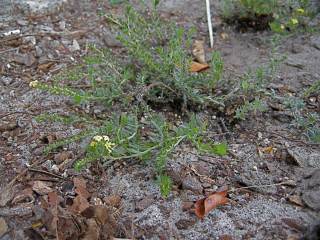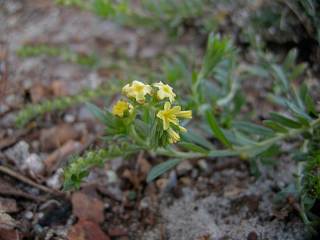Our old house in Boca was just starting to enjoy some great trees and shrubs after our native plant makeover of several years back, but it was a little light on wildflowers. Sure, we had tropical sage (Salvia coccinea), but that was really about it. We had planted lizard’s tail, scorpion tail, and a few other perennials, but they all sort of got tired of living there, I guess, because they all sort of disappeared. Even my pickerelweed and blue flag iris sort of petered out after a while, although they’re both still around over there, and I didn’t really know what to do to cultivate/renew/rejuvenate them.
Now that I’m in a new place, and am a card-carrying member of FNPS, though (not literally; if they issue membership cards, I didn’t get one in my packet) I intend to lean heavily on the wisdom and experience of the membership of that organization to keep my new plantings, wildflowers included, ship-shape.
One tiny little plant (two, actually) taking pride of place right now in the new plantings is Heliotropium polyphyllum, Pineland Heliotrope. It’s sort of accidental that it’s taking pride of place: there were two containers of H. polyphullum in the auction lot, whereas all the other plant species I came home with that night were singletons.
According to Craig Huegel, Pineland heliotrope comes in two different forms, one of which grows up to 12 inches high, while the other is a recumbent species not getting much above 3 inches off the ground. Apparently the difference in growth form is also accompanied by a difference in flower color: the yellow variety grows tall, while the white variety stays small.
Here are a couple of shots of my scraggly little guys, about as high right now as the white variety will ever get, but these are yellow:
You can see by the height of the plant stake in the background just how shrimpy these newbies are; if they’re 2 inches high, I’ll be surprised. Here’s a closeup:
Rufino writes that “with just a little coddling” these can grow into impressive plantings. I’m not really clear on what it means to “coddle” them, but I’m watering them assiduously and keeping my fingers crossed. I’ll save the coddling for the kids…
In case you’re curious about the derivation of the name, Heliotropium means turning toward the sun, apparently in reference to the curving flower cluster rather than any specific sunflower-like activity (although I’ll have to watch for it to see); polyphyllum means that it has many leaves.


